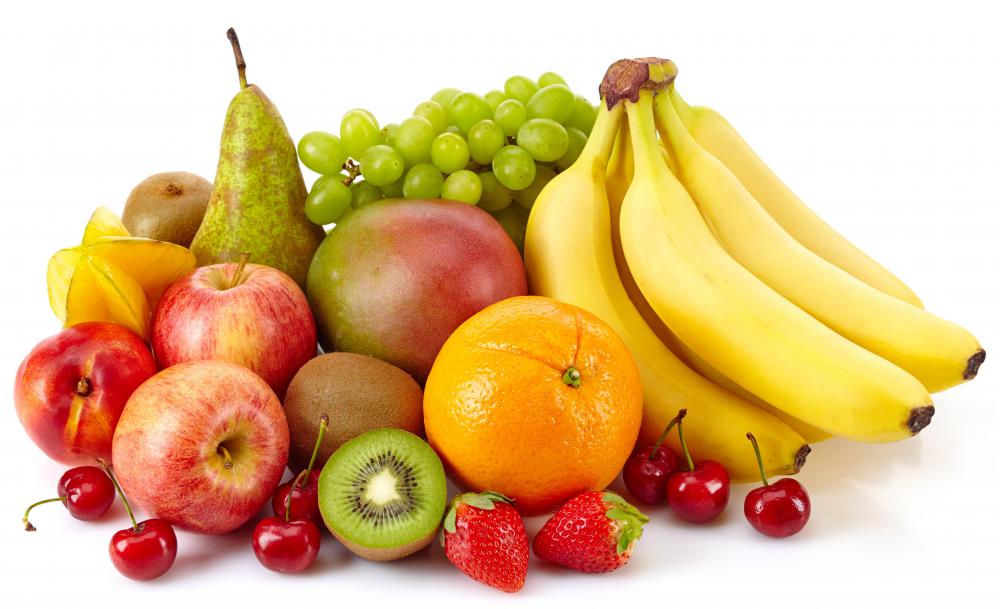At WiseGEEK, we're committed to delivering accurate, trustworthy information. Our expert-authored content is rigorously fact-checked and sourced from credible authorities. Discover how we uphold the highest standards in providing you with reliable knowledge.
What Is Carbohydrate Chemistry?
Carbohydrate chemistry describes the structure, properties and reactions of the compounds of carbon, hydrogen and oxygen known as carbohydrates. These compounds have the general formula C(H2O)n, where n can be any number from three upwards. It can be seen that carbohydrates always contain hydrogen and oxygen in the proportions of water (H2O), hence the “hydrate” part of the name. Carbohydrates include sugars, starch, cellulose and many other common substances. They are manufactured from carbon dioxide and water by photosynthesis in plants and are an essential energy source in the diets of all animals.
The simplest carbohydrates are trioses, with just three carbon atoms. Carbohydrate chemistry can, however, can be quite complex, as numbers of small carbohydrate molecules can be joined to form much larger structures. Simple carbohydrates, such as glucose, are known as monosaccharides. Carbohydrate chemistry advanced significantly when the detailed structures of many monosaccharides were first clarified by Emil Fischer, a German chemist, in the late 19th century. Complex carbohydrates consist of monosaccharide units bonded together.

Molecules consisting of two monosaccharides are known as disaccharides; a common example is sucrose — better known as table sugar — which consists of the monosaccharides glucose and fructose. Oligosaccharides have several monosaccharide units, and polysaccharides consist of long chains of these units, sometimes numbering thousands; examples are starch in its various forms and cellulose. Each molecular unit in the chain is joined to its neighbor by a glycosidic bond, which is formed by the removal of hydrogen (H) and hydroxyl (OH) groups — forming water — from adjacent monosaccharide molecules.

Carbohydrate structures are such that different molecules can have the same overall formula, with the atoms arranged differently. Monosaccharides, for example, can be divided into aldoses, which have and aldehyde group, and ketoses, which have a keto group — a carbon-oxygen double bond also known as a carbonyl group. Although glucose and fructose have the same chemical formula (C6H12O6), they are differently structured: glucose is an aldose and fructose is a ketose. This is a common feature of carbohydrate chemistry.
It is also possible for a type of carbohydrate to exist in different forms. Glucose can take a linear form, with its six carbon atoms forming a short chain; the carbon atoms can be numbered C1-C6, with C1 forming the aldehyde group and C6, at the other end, bonded to two hydrogen atoms and a hydroxyl group. The four carbon atoms in between each have a hydrogen atom on one side and a hydroxyl group on the other. There are two forms of glucose, D-glucose and L-glucose, which differ only in that the former has just one of its hydroxyl groups on the same side of the molecule as the oxygen from the aldehyde group, while in the latter, this arrangement is exactly reversed. This applies to many monosaccharides, with the “D” forms predominating among natural sugars.
In solution, D-glucose tends to form a ring structure, with C6 pushed to one side and the hydroxyl group on C5 reacting with the aldehyde group on C1 in such a way that a six-atom ring is formed with 5 carbon atoms and one oxygen atom. This is known as a glucopyranose ring. The ring can take two different forms, depending on the position of the hydroxyl group on C1. If it is on the same plane as the ring, the compound is known as β D-glucopyranose, but if it lies perpendicular to the plane of the ring, it is known as α D-glucopyranose. The two different forms are known as anomers and the C1 carbon atom is known as the anomeric carbon.
The β form looks more structurally stable, and in the case of D-glucopyranose it is, but in some monosaccharides, the α form is more common. This is because in these compounds, the electrostatic repulsion between the electron pairs in the anomeric hydroxyl group and those from the oxygen atom in the ring can overcome the greater structural stability of the β form, a phenomenon known as the anomeric effect. Which form is more stable depends not only on the compound, but also on the solvent and on temperature.
The hydroxyl, aldehyde and keto groups in carbohydrates can be replaced by other groups, allowing a wide range of reactions. Carbohydrates form the basis of many other biologically important compounds. For example, ribose and deoxyribose, a related compound, are the fundamental units from which the nucleic acids DNA and RNA are formed. Glycosides are formed from carbohydrates and alcohols; Fischer glycosidation, named after Emil Fischer, involves the use of a catalyst to form the glycoside methyl glucoside from glucose and methanol. Another route to glycoside production is the Koenigs-Knorr reaction, which combines a glycosyl halide with an alcohol to form the glycoside.
AS FEATURED ON:
AS FEATURED ON:












Discuss this Article
Post your comments